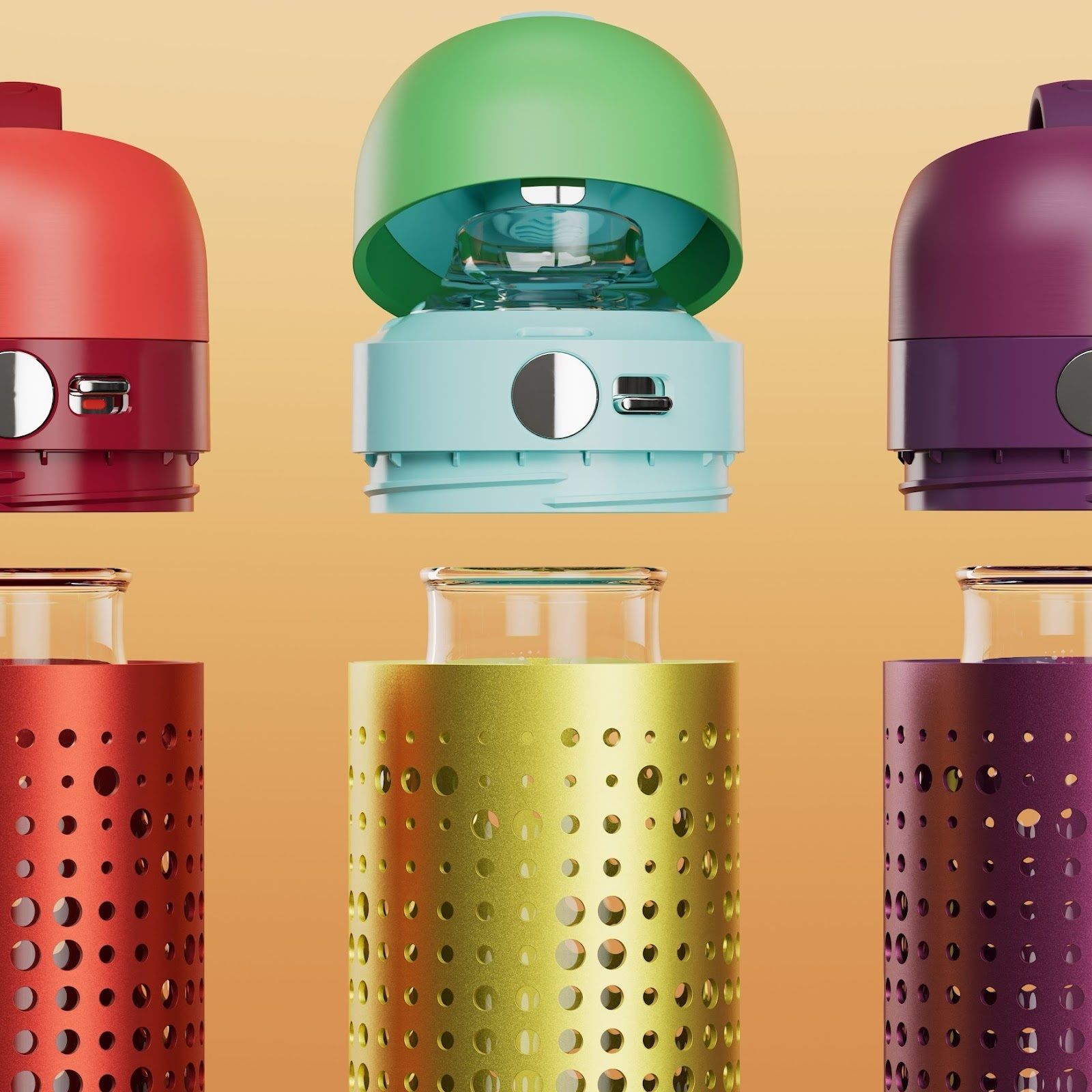“What does it do?” my friend asked as we sat there staring at the chrome-pink, futuristic looking cylinder set on the table. “It’s just a water bottle,” I said.
“It doesn’t filter your water? Keep track of how much you drink?” she asked. I shrugged. “Nope, I guess it does look cool though.” My friend was asking because Okapa, a brand with just one product, sells its flagship water bottle for $295.
For context, most high-end water bottles top out around $50, or maybe $100-150 if they have fancy features like self-cleaning UV lights, built-in filters, or app connectivity to monitor your drinking habits. When a brand charges that much more than market value, it’s usually for one of two reasons: either it’s a luxury product meant as a status symbol, or it’s solving a consumer problem no one else has cracked.
Okapa is claiming to do both. Its Instagram bio says “luxury hydration”, and it’s tapping the fashion world to find its clientele by partnering with a small designer for a New York Fashion Week runway show. But, also, Okapa claims its bottle redefines hygiene and durability, using materials typically found in medical and aerospace applications.
Indeed, Okapa says it’s taken eight years of R&D and more than 10,000 prototypes to achieve the “micron-level precision” of its bottle, and in the process secured more than 70 patents globally. Incidentally, in case you’re wondering what Okapa means, or where it comes from, according to the company it is, apparently, a mindset. “We’re calling it ‘The State of Okapa’ where the unthinkable is being realized” says the website bumf. The site then adds the bottle itself is “a technical feat of engineering beyond reason.”
No stranger to the luxury market, or indeed hyperbolic product promises, Okapa’s founder Hardy Steinmann cut his teeth in the 80s and 90s running the marketing and sales for high-end watch brand Hublot in the USA, then relaunching Swatch Group’s Hamilton watch brand globally.
Anyway, do those medical and aerospace materials actually make a difference in a water bottle? Can a water bottle really redefine hygiene? I tested it for nearly two months and spoke to a medical toxicology expert to find out.
Initial Thoughts
Before I even got my hands on the water bottle, I saw the website. It has a retro video game aesthetic with the pixelated text and sliding transitions. Even the user manual is illustrated in that same playful style. And I’m a sucker for a company that puts that much intention into branding design and overall vibe.
When I unboxed the water bottle, I was even more sold. This thing is beautiful. The lines are clean, the dot pattern is eye-catching, and the finish has a soft matte sheen that looks and feels expensive. I got the pink-and-yellow colorway (“Peaches Copperwire”), but there are eight total, from all-black to bright red. Each has a name that sounds more like a budget sci-fi movie character than a color, like “Redd Rumble” or “Mitsi Pinku.”
With such a distinctive design, would my fancy water bottle elicit jealousy of my peers or strangers? Could they even tell it cost so much? I toted this throughout airports, to spas, to work events in New York City, and on trains in Europe. I kept it in hand, swinging from my fingers, fishing for compliments. I got none.
The Testing Experience
Water bottles are a pretty basic product, so the engineering and details of the Okapa bottle surprised me. First, it is really satisfying to drink from. The lid opens with the push of a button and lets out a clean little “pop” as the spring-loaded top snaps back. It’s smooth to open with one hand, and as you tilt the bottle to get every last drop, the cap stays neatly out of the way instead of flopping forward to bonk you on the forehead.
The mouthpiece shape fits perfectly when you purse your lips, and the Swiss-made Grilamid plastic feels softer and more premium than most. It also has a locking mechanism that works exceptionally well. Even when I forget to engage the locked mode, the cap has never popped open in my bag. (I once ruined a laptop when an Owala opened mid-commute, so I appreciate a trustworthy latch.)

The Okapa water bottle can be completely disassembled for cleaning.
Photograph: Hannah Singleton
This completely recyclable bottle can handle both hot and cold liquids, as can other borosilicate glass water bottles. You can remove the inner glass carafe, fill it with tea or warm water—even microwave it—then slip it back into its aluminum shell.
The handle, though, could be better. It’s only big enough for a couple of fingers, so it’s not the most comfortable to carry for long stretches.
What Does “Medical Grade” Mean?
Now, to the materials. “Medical-grade”—in relation to water bottles—means very little. While the term may sound impressive and brings to mind high safety standards, “it is often just a vague marketing term that hides the real complexities and plays on people’s worries about chemicals,” says Dr. Gerome Burke Jr., board-certified medical toxicologist and program director for research and reporting at the FDA’s Center for Drug Evaluation and Research. “It leverages the prestige of the medical field to create a perception of heightened safety and performance that is not substantiated by regulatory science.”
The FDA doesn’t have an official “medical-grade” designation for bottles or cups, so in practice, it doesn’t mean much more than “food-grade.” Any plastic approved for food contact already meets safety standards, Dr. Burke tells me. Instead, what’s important is a company’s transparency about material composition and its commitment to avoiding known hazardous chemicals, like PFAS, he adds.
Still, Okapa argues that its use of “medical-grade” materials isn’t just for show. The company told me that every surface in contact with water—borosilicate glass, silicone, nylon, and stainless steel—is “chemically inert,” meaning it won’t leach plasticizers, metals, or PFAS. If you’re concerned about microplastics, this could be a selling point.

The durable design only picked up this tiny scratch during our two-month tryout.
Photograph: Hannah Singleton
The materials can withstand high temperatures (up to 110°C, or 230°F) without deforming, which makes it more durable but also easier to sterilize and less prone to bacterial buildup than soda lime glass or cheap plastic, the brand says. However, there are many other borosilicate glass water bottles that are much cheaper, such as Purifyou’s model, and that costs just $25. Moreover, stainless steel, one of the most common water bottle materials, is also heatproof.
But, ultimately, the materials themselves probably won’t make your water safer. The real hygiene issue comes down to user behavior. Most bacteria enter water bottles through stagnant water and infrequent cleaning. To its credit, Okapa makes that process easier: the entire bottle disassembles so you can scrub every part individually, and all of the pieces except the metal shell are dishwasher-safe. Even the cap breaks down into two pieces, and all the silicone rings pop out.
Durability Testing
While, just like Dr. Burke, I’m more than a little skeptical of the “medical-grade” claims, I’m totally sold on the durability claim. After nearly two months of daily testing, the only scratch I could find was a splinter-sized nick on the base. (All of my other water bottles are completely banged up after the first week.)
I was pretty heavy handed with it, too. Once, I hit it too hard on a counter and was sure the inner glass had shattered. Another time, it fell off my bathroom counter onto tiles. Both times, it came out unscathed. The anodized aluminum outer shell absorbed the shock to protect the glass carafe better than I expected.
The smaller components, like the push-button hinge and locking mechanism, are made from Nitronic 60 stainless steel, the same kind used in surgical instruments. I can’t speak to its longevity yet, but the craftsmanship feels intricate and sturdy. The brand backs its product with a one-year warranty.
Final Thoughts
I really didn’t want to love this water bottle, but I do. Every design detail, apart from that handle, is excellent. I’ve tested a ton of water bottles, and nearly every other model has some little annoyance—like a stubborn twist cap, leaky seal, or a hard-to-clean straw. Each flaw adds up over time until I eventually stop carrying them. And people lug their reusable water bottles everywhere with them, so I understand the appeal of a product that eliminates those daily frustrations.
But would I pay $300 for it? No. Of course not. The simple fact is you can get something nearly as good for a fraction of the price. Still, that said, as it damn well should be after 10,000 prototypes, I can’t deny it’s the nicest, most thoughtfully designed water bottle I’ve ever tested—whether it protects my body from forever chemicals or not.



